Developer: Konami Publisher: Konami Release: 12/15/95 Genre: Shooter
The Parodius games have always been the secret best series you’ve never heard of. That is mostly due to their minimal presence in the US. While the arcade games received excellent SNES ports Konami blessed the system with an exclusive entry in 1995. Jikkyou Oshaberi Parodius was a late 1995 release that pushed the system hard to deliver the same thrills as the arcade. It not only succeeded in that task but came with an interesting hook as well.
Jikkyou Oshaberi Parodius roughly translates to Live Chatting Parodius, a title it lives up to. Commentary became more and more common later in the 16-bit era, especially in sports games. Jikkyou Parodius dedicates a large portion of its memory to enabling running commentary throughout the entire game. In practice it is very similar to Japanese variety shows and I’m sure is pretty cool. Sadly it is lost on those of us not fluent in Japanese. Most of it isn’t crucial anyway; it’s mostly warnings when enemies will attack, commenting on the coming level, and berating you when you die. I will admit; it’s pretty funny to hear an angry old Japanese man cut you down because you suck.
While the commentary is a large part of the game it is not the most important. Nearly every facet of the game has been upgraded starting with the playable characters. The cast has tripled in size from the previous game to sixteen characters pulled from nearly every Konami series. The perennial favorites all return with most of the new characters being originals.
Parodius has always used other Konami games as source material for parody. Usually it was relegated to just the shooters. With Jikkyou Oshaberi Parodius the series goes full retard for lack of a better term. Any and every Konami game has a target on its back and some of the choices are just plain bizarre. Tokimeki Memorial has no meaning for us in the west. But in Japan it was an insanely popular Super Famicom dating sim which is why it is so prominent here. This level takes place in a Japanese high school with its boss being a pair of stacked schoolgirls. Weird.
If that sounds strange then you will be surprised to see even Lethal Enforcers gets a shot. The setup is actually pretty genius. The moving targets and obstacles are combined with the fast pacing of the Speed Zone from Gradius III. It adds an interesting dynamic to a familiar stage, to say nothing of its theme. Of course it shouldn’t be so strange as Lethal Enforcers is a shooter, just not a shmup. Now what the end level boss (a Kabuki actor) has to do with it is anyone’s guess.
While these examples seem a bit obscure the rest of the game is more mainstream. There are levels that pay homage to Legend of the Mystical Ninja, Xexex (a great arcade shooter) and Twinbee. I especially liked Mystical Ninja Land as it is a loving tribute to that series. It also has one of the more frustrating but satisfying boss battles in the game. At eight levels Jikkyou Oshaberi Parodius is slightly shorter than previous titles. The inclusion of battery backup is a bit strange in light of this, not that I’m complaining. Aside from trying out other characters the only incentive for replay value is finding the seventy fairies. They are extremely well hidden although sadly your only reward is a stage select.
Jikkyou Oshaberi Parodius is probably the most difficult game in the series which says a lot. The game is faster than its predecessors which is surprising. As a result enemies are more aggressive and spawn in greater numbers. That pace never lets up, even during the intermissions between levels. And this is on the default setting! One benefit to the increased chaos is the presence of slowdown. Previous games were more restrained which nearly eliminated it altogether. Here if you are using a character such as Doitsu/Soitsu with their 3-way shot you can initiate slowdown manually. It makes the brutal boss battles manageable even if it feels like cheating. It will take some time before you see the end of this one.
As a late Super Famicom release Jikkyou Oshaberi Parodius looks fantastic. The sprites are larger, the explosions bigger and the backgrounds are beautiful. The game makes extensive use of pre-rendered objects which clash a bit but is still fairly impressive. More than anything else each level just seems alive; not just in activity but also background animation. The SA-1 chip allows some polygonal effects but mostly to compress data, enabling the large volumes of spoken dialogue.
Few cartridge games from that period had this much sampled speech. Aside from dialogue the soundtrack is similarly fantastic. Most of the levels are based on other Konami titles and as such the music features many remixes of classic tunes. The sound is higher quality than most SNES titles, making this one of the system’s most technically proficient games.
In Closing
As a console exclusive Jikkyou Oshaberi Parodius continues the series streak of excellence and is one of the best shooters for the SNES. It also holds up favorably against the later Saturn and PlayStation ports. Regardless of the version this is a truly great game.
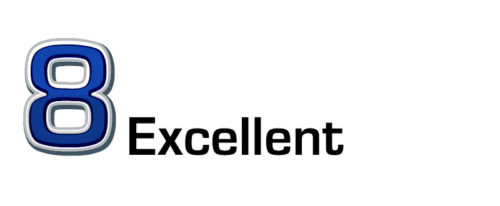

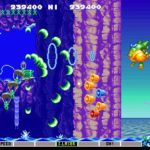
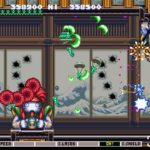
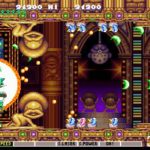
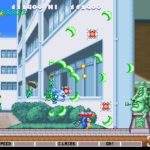
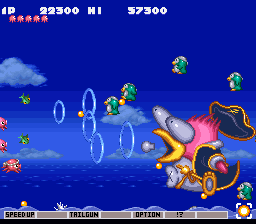

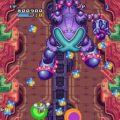
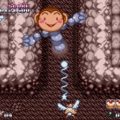
One thought on “Jikkyou Oshaberi Parodius”